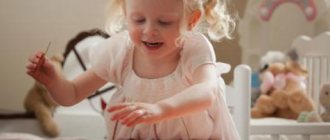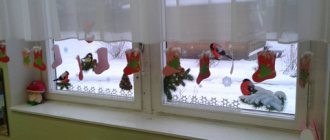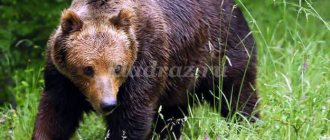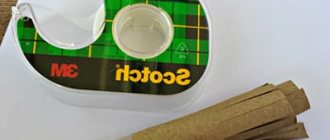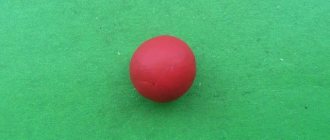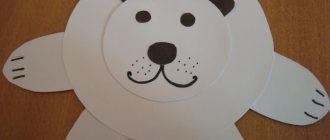Lesson on the topic “Vegetables and fruits”
Summary of a lesson on familiarization with the environment
for children with special needs level 3, 3 years of study
on the topic "Vegetables and fruits"
Tasks:
To consolidate children's ideas about fruits (apple, pear, orange) and vegetables (tomato, cucumber, carrot): name, appearance, place of growth, who plants.
Exercise children in determining the qualities of vegetables and fruits: shape (round, elongated), color (red, yellow, green, orange), forming phrases (noun + adjective).
Strengthen the ability to differentiate vegetables and fruits.
Strengthen the ability to form singular and plural nouns in speech.
Develop visual, tactile perception, concentration, attention span, verbal memory, visual-figurative and verbal-logical thinking.
Help strengthen the ability to answer questions in complete sentences.
Help consolidate the ability to act in accordance with the teacher’s instructions.
Cultivate a desire to help others.
Integration of educational areas:
physical development, speech development, artistic and aesthetic development.
Vocabulary work:
a lot
,
gardener, gardener.
Preliminary work:
Examination of plot paintings on the topic “Vegetables and fruits”
Reading the fairy tale “Turnip”
Individual work:
With Ksyusha
to improve skills in naming vegetables and fruits and arranging them on plates
With Katya
to improve the ability to write simple sentences on issues
Materials and equipment:
Demonstration: Olympic bunny, bag, ball, pictures of beds and trees
Handout: 2 plates, natural fruits and vegetables (apple, pear, orange, carrot, tomato, cucumber), gifts for children.
Progress of educational activities
Organizing time:
There's a knock on the door and the Olympic bunny runs in
Hello, guys, I'm the Olympic bunny, I brought you a wonderful item from the Olympics, and it's wonderful because it is given only to winners.
The bunny shows the bag.
What is this wonderful object? (children's answers). Pouch.
Nobody knows what's in the bag except the winners, they gave me a clue, but I can't figure it out. Help me guys.
Main part:
During all the game exercises, I stimulate the children’s speech activity by asking clarifying questions and questions to describe their actions.
Game exercise “What’s inside?”:
Let's help Bunny find out what's in his bag.
Now each of you will put his hand into the bag and try, without looking, to determine what he got into his hand, and tell him why you decided so.
Children take turns placing their hand in the bag and, using tactile inspection, guess what is in their hand. These items are left on their plates.
Guys, what was in Bunny’s bag? (children's answers). The bag contained vegetables and fruits.
Let's tell you what they are.
Children take turns making up phrases that describe a specific fruit or vegetable, for example, a green apple.
Game exercise “What grows where?”:
To carry out individual work, I ask questions as support for drawing up a proposal
Bunny: - Now I know what was in my bag. But I don't know where all these vegetables and fruits grow.
Let's tell and show Bunny where each vegetable and fruit grows.
Where do vegetables grow? (children's answers). Vegetables grow in the garden.
Where do fruits grow? (children's answers). Fruits grow on a tree.
I hang pictures of beds and trees on the board.
Where do vegetables grow? (children's answers). Vegetables grow in the garden.
Guys, who grows vegetables? (children's answers). The vegetables are grown by a gardener.
Where do fruits grow? (children's answers). Fruits grow in the garden.
Who grows the fruit? (children's answers). The fruit is grown by a gardener.
I show a picture of a fruit or vegetable and the children name it. I ask who grows it. Then, whoever named it correctly comes out and hangs it on the board.
Now do you understand, Bunny, where vegetables and fruits grow, and who plants them?
Hare: Got it, thanks guys.
Game exercise “Decompose”:
Look, we have all the products mixed on the table, let's help Bunny arrange the items so that he can better understand. I have two plates: in one plate we will put fruits, in the other we will put vegetables.
I divide the children into 2 teams: 1 team lays out vegetables, 2 - fruits. At the end of their activity, we check whether everything is laid out correctly.
Game exercise “One-many”:
The Olympic Bunny wants to see how dexterous and smart you are.
I throw a ball to each of you and name a fruit/vegetable in the amount of one item, you must catch the ball and name the same fruit/vegetable so that there are a lot of them.
For example: There is one apple, but there are many... (apples); There is one cucumber, but there are many... (cucumbers); There is one pear, but there are many... (pears), etc.
I throw the ball to each child in turn and name the fruit or vegetable in the singular; children catch the ball and, pronouncing the same vegetable or fruit in the plural, throw the ball back.
Look, Bunny, how dexterous and smart the guys are, they haven’t made a single mistake!
Final part:
What did we talk about today? (children's answers). Today we talked about vegetables and fruits.
What vegetables and fruits? (children's answers). About apple, pear, orange, tomato, cucumber, carrot.
Where do fruits grow? (children's answers). Fruits grow in the garden.
Where do vegetables grow? (children's answers). Vegetables grow in the garden.
Who grows vegetables? (children's answers). The vegetables are grown by a gardener.
Who grows the fruit? (children's answers). The fruit is grown by a gardener.
Qualitative assessment of children’s activities: I praise and note those who were more active and took direct part in the lesson.
Bunny, did you like how our guys did the lesson?
From the Hare's perspective:
Guys, you are so great! I really enjoyed playing with you. You were all so smart and quick-witted! You helped me figure out what was in my bag. For this I want to give you small gifts as souvenirs.
The hare gives gifts to children.
And now it’s time for me to return to the Olympics.
Summary of a lesson on speech development in the first junior group “Fruits”
Lesson summary on speech development
in the first junior group “Fruits”
Fruits.
Target:
systematize children's knowledge about fruits
Tasks:
— improve the skill of writing a descriptive story;
- activate the word “multi-colored” in speech;
— introduce the concepts “fruit trees”, “orchard” into the active dictionary.
— improve communication skills
Equipment:
tree layouts pictures of fruits fruit layouts envelope with letter ball plates paper cut fruits for trees
Progress of the lesson
- Hello guys! Look how many guests came to us today, let's say hello to them.
— Guys, today we received a letter from our friends from another kindergarten.
- Guys, they invite us to play and solve riddles. (Children sit on chairs in a semicircle and look at the ICT board)
1.
Round, rosy
I'm growing on a branch
Adults love me
And little children (apple)
(On the ICT there is a picture of an apple and tell what it is according to the diagram; then there are pictures of the guessed fruits)
.
2.
Bright, sweet
All in the cover poured!
Not from a candy factory
From distant Africa. (orange)
3.
There is a fruit in the little garden, It’s as sweet as honey, It’s as rosy as a roll, But it’s not round like a ball, It’s stretched out a little right under the leg. (pear)
4.
Blue uniform
Yellow lining
And it's sweet in the middle. (plum)
- Well done boys. All the riddles were solved.
- Guys, how can you call an apple, orange, pear, plum in one word? What is this? (fruits)
.
— Guys, where do fruits grow? (on the trees)
.
— What are the names of the trees on which fruit grows? (fruit)
—Where do fruit trees grow? (in the garden)
— What is the name of a garden in which there are many fruit trees? (Orchard)
.(ICT orchard)
- Well done!
- Guys, today we will go on a trip to a fabulous orchard. What time of year is it outside now? (late fall)
. And we will visit the garden where it is always summer.
“But the road for us, guys, will not be easy; we will play along the way.” I will name you fruits and vegetables; when I name vegetables, we must walk on our haunches; when I name fruits, we walk on our toes; we pull our hands up toward the sun. (sounds of birds and insects)
- Guys, we’ve come to the garden. Let's sit down on the bench.
— Guys, what trees grow in the garden? (apple trees, plum trees, cherries, pears, orange tree)
- What fruits grow on apple trees, pears, cherries, plums, etc.?
- Well done!
— Guys, please tell me why we people grow so many fruits? After all, if you don’t eat them all at once, they will go bad? Let's talk about how you can store fruits (cook, dry, freeze)
.
What can you cook from fruits? ( jam, compote, juice, marmalade)
- Let’s stand in a circle and play the game “Treats” (ball game)
Children stand in a circle. I am the presenter, throw the ball, for example to Katya S. and ask: “What kind of orange juice?”, Katya – “orange”, etc., I have to play with each child.
“Now let’s slowly sit down on the bench.” Guys, look carefully, are our fruits all the same? (no) (ICT picture with different fruits)
— How do fruits differ from each other? (shape, color, size)
- For example, Zhenya, name us a fruit that is round or oval in shape. Well done!
— Guys, what color are the fruits? (red, yellow, blue, orange, etc.)
— How to say in one word about the color of fruit? (multi-colored. Repeat this word in chorus with the children)
Let's all go to the table together.
-Guys, now you and I have to complete the following task: I will give you two pictures cut into 4 parts; you need to fold them. You should get two pictures. (description according to the scheme pear, orange)
— Guys, let's play the game “Find the odd one out.”
Work in pairs. Children sit in pairs. I hand out plates with mock-ups of fruits and vegetables on them, and the children must find the extra ones. For example:
- apple, pear, onion,
plum;
- orange, potato
, lemon, grapes
- tomato, cucumber, banana
, carrot
- eggplant, pepper, pear
, cabbage
I check the children's answers. Seek a complete answer.
- Guys, let's go back to the orchard, sit on a bench and play the game “One - Many.” For example, I say: (one - pear, many - pears; lemon - lemons; plum - plums; etc.)
- Look, I have multi-colored apples: red, green. Take a green apple for those who were very interested today, it’s clear, it’s not difficult. The red apple will be taken by those who were interested, but found it a little difficult to complete the tasks. Let's now attach your apples to a tree in the garden and see what kind of apple tree will grow in our garden.
- Look, guys, what a beautiful apple tree we have.
-And now, you and I need to return to our kindergarten. Remember the game we already played, I will name you fruits and vegetables, when I name vegetables - we must walk on our haunches, when I name fruits - we walk on our toes, we pull our hands up towards the sun. (sounds of birds and insects)
“Here we are back, sit down on the chairs.” Our lesson is coming to an end.
- Guys, what did we talk about today?
—Where did we travel?
— Why is the garden called an orchard?
Let's go to the music.
List of sources used:
- https://nsportal.ru/detskiy-sad/logopediya/2012/02/17/konspekt-zanyatiya-frukty
